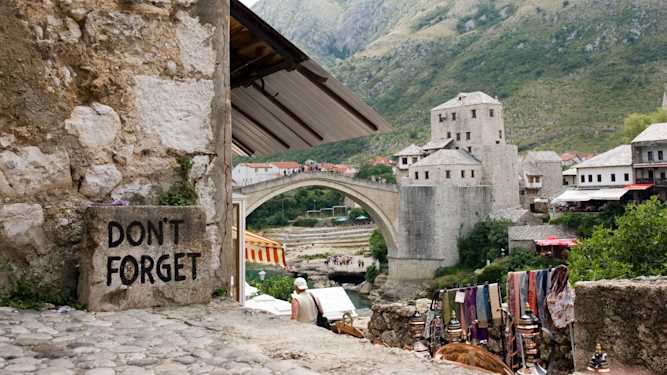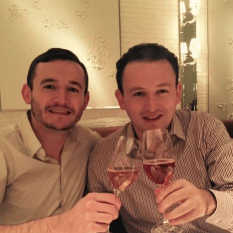
Bosnia 2025 - September
Throughout 2025, Ian Bancroft is collecting reflections on Bosnia-Herzegovina thirty years on from the end of the war. These reflections, supplemented by other insights and stories, explore various dimensions (peacebuilding, reconciliation, culture,education, politics), while reflecting on the past and the future.
To contribute your reflections on Bosnia-Herzegovina, please click here.
Read previous months here:
I have the privilege of posing some questions to Mensud Kečo, one of BiH’s most renowned artists and sculptors. His award-winning portfolio includes the ‘Monument for children killed during the war in the occupation of Sarajevo 1992-1995’ and a memorial to two famous Bosnians - rock star Davorin Popović and basketball player Mirza Delibašić. And, of course, the aforementioned sculpture, ‘Nermin, come’ (‘Nermine, dođi’), dedicated to the Srebrenica genocide.
For Mensud, the process of reconciliation in BiH is ‘very difficult and slow, and I don't think it will happen anytime soon, as long as those who are currently in power are in power, because they don't like any reconciliation.’ Their motives remain a key hindrance. ‘The only way to stay in power is to have no reconciliation,’ he states, ‘everyone talks about reconciliation, but in fact they don't want it.’
Mensud believes the only path forward is a change in the country's educational system to ‘face the past in the right way.’ To this end, he calls for the creation of ‘a common education system - teaching history that really happened, working directly on reconciliation, explanation, forgiveness, the truth about what happened and what was in the past.’ It would create, in his words, ‘a science for the future.’ He firmly doubts, however, that those currently in power are capable of achieving this.
In the absence of fundamental educational reform, art can serve as an even more powerful tool for social change and reconciliation. ‘I think that artists can do a lot and help in the very process of dealing with the consequences of war and displacement among people,’ he tells me. Mensud notes that the history of BiH naturally influences artists, who respond to the past and present, hoping to shape the future. ‘They are the ones who should and who can do something about it,’ he concludes.
For an anonymous contributor, a survivor of the Srebrenica genocide, ‘the post-war transition is not going well because we have an “unjust peace”.’ It is a concept that is regularly proclaimed but rarely explained.
They elaborate without hesitation. ‘I was expelled from the eastern part of BiH with my mother in the most brutal way,’ they being, ‘and in the genocide in Srebrenica, my father and brother were killed, as well as numerous members of my extended family.’ And yet, when peace was concluded, this territory - where they had lived before the war - was, in their words, ‘named Republika Srpska.’
‘No matter how the constitutional order of BiH explains the concepts of entities,’ they continue, ‘the fact is that from that moment, since that peace, me and my family members - who are not Serbs - have been discriminated against in the territory of the Republika Srpska entity.’ ‘We are also very clear about what the word Republic means,’ they add.
An anonymous contributor from Sarajevo reflects philosophically on the passage of time. ‘Whilst thirty years seems like a long time for a person - and at first we might think that much more could and should have been done,’ they reflect, ‘however, when it comes to transitional justice, thirty years is not so long.’ Peace is, in their words, ‘on shaky ground,’ with war criminals increasingly glorified and genocide and other war crimes denied.
They are, however, ‘optimistic about the younger generations,’ arguing that ‘they seem to be more willing to work for peace than the older generations - namely those who directly participated in the war.’
The contributor exercises a note of caution. ‘We should also be careful with young people,’ they contend, ‘because many grow up in small local communities and do not have access to the other side of the story.’ It is this fact that leads them to regret the missed opportunities in education, especially in ‘peace education.’
Peace education is a holistic approach to how peace is understood and achieved in our communities. It is grounded not just in knowledge and skills, but in specific values, attitudes, and behaviours. At its core is a focus on non-violence and social justice, with a belief in the possibility of positive change. It addresses conflict at multiple levels and works to address the root causes of conflict that can lead to violence.
On what positives they’ve seen in BiH in the past thirty years, they don’t answer. I try not to interpret this to mean that there weren’t any.
Another anonymous contributor from Banja Luka is unequivocal in declaring that ‘BiH has lost 30 years thanks to the international community and its indecisiveness to leave the deal to local representatives.’ BiH is, they insist, ‘a failed protectorate,’ albeit one where ‘peace has been achieved and will remain so.’
They believe that reconciliation is essentially impossible as ‘Bosniaks believe they should have been the winners, Serbs believe they should return to the original Dayton, and Croats still dream of a third entity.’
‘I am a pessimist,’ they declare, adding that the biggest missed opportunity was that ‘we did not drive out the foreigners with a shitty stick.’
To contribute your reflections on Bosnia-Herzegovina, please click here.
You can also contact Ian directly by clicking here.
Ian is a writer based in the Balkans. He is the author of 'Dragon's Teeth - Tales from North Kosovo' and 'Luka'. Follow Ian on Twitter @bancroftian.
Currently in: Belgrade, Serbia — @bancroftian
